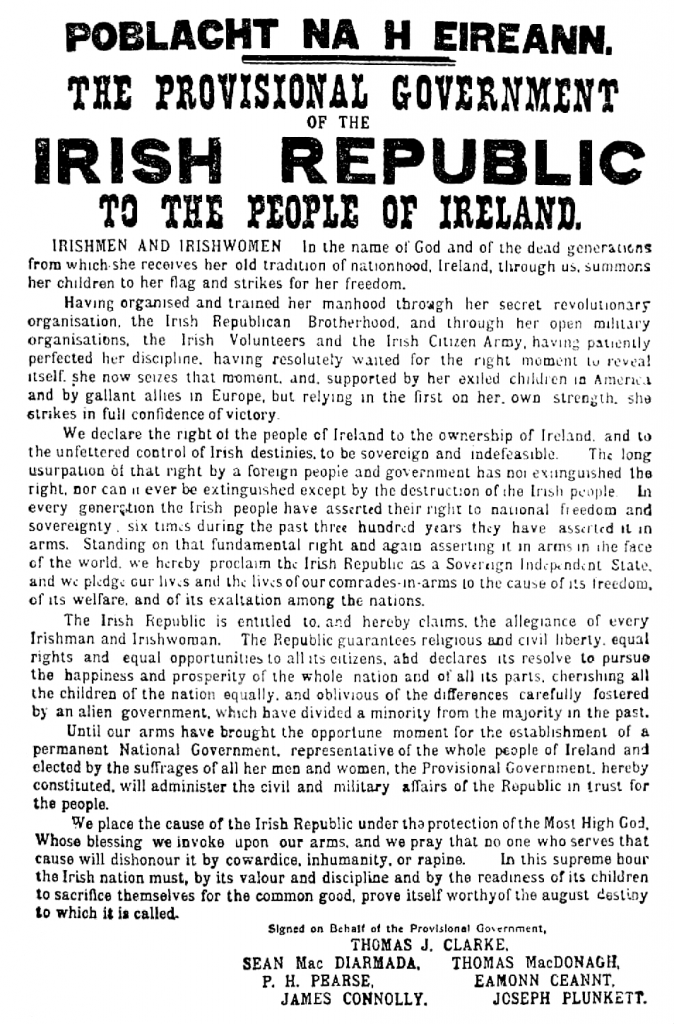IRISH HISTORY SINCE 1850
2. An Gorta Mór
3. The Land League
4. Parnell and Home Rule
5. Unionism
6. The Cultural Revival
7. Home Rule
8. The Easter Rebellion
9. The War of Independence
10. The Free State: '20s
11. The Free State: '30s
12. The Troubles: '60s & '70s
13. The Troubles: '80s & '90s
14. The Celtic Tiger
15. Death of the Tiger
16. Sources

The Easter Rebellion
While everyone's attention was turned to the battles against Germany the advanced nationalists began plotting. A long-held belief in the nationalist tradition was that England's difficulty was Ireland's opportunity. What could be more difficult than a World War? So in 1915 the IRB began plotting a rebellion against the British. The plan was for a nationwide rebellion by the IRB forces which would lead, in turn, to a popular uprising. The date was set for Easter Sunday 1916.
Sir Roger Casement was enlisted to gather arms and support for the Rising from Irish allies — who better in a time of War than the Germans who had their own reasons for destabilizing Britain by supporting havoc in Ireland? The Germans donated 20,000 rifles and ammunition to the cause. On Good Friday 1916 Casement was delivered to the coast of Kerry by submarine and awaited the delivery of the weapons from the German ship, the Aud. The rebellion was under way.
The British became aware of a strange German ship off the coast of Ireland, and attempted to intercept the Aud. Its captain, rather than be caught with his cargo, scuttled the ship. The rebellion had suffered its first, and maybe fatal, blow. Despite attempts to call off the rebellion in face of the loss, the decision was made by IRB leaders, such as Patrick Pearse, to go ahead with it on Easter Monday.
While the citizens of Dublin enjoyed a public holiday and many members of the British forces were at Fairyhouse races, the rebels, a combination of IRB and Irish Citizen Army members, captured, or rather walked into, key buildings across Dublin and declared a Republic in the name of the Irish people. The British were slow to react, but once they did their answer was swift and brutal. Within a week the rebellion was crushed, much of central Dublin was destroyed and 500 from both sides killed. All the leaders were arrested, and 14 were executed, including the seven who had signed their names on the Proclamation.
The insurgents of 1916 were led by the IRB, a secret organization. The British had no clear-cut image of who was leading the Rebellion, and in the aftermath the press began referring to the event as the Sinn Fein Rising. Although this led to many Sinn Fein members and other nationalists being arrested in the wake of the Rebellion, whether involved or not, it fixed the party at the forefront of the public mind as the leaders.
Although the Rebellion failed, the reading of the Proclamation outside the General Post Office was one of its most important moments. Read by Patrick Pearse, the newly appointed President of the Republic, to a small and probably bemused crowd of people, the Proclamation defined the nature of the Irish Republic and gave future nationalists an ideological blueprint. It declared the "Irish Republic as a Sovereign Independent State," promised universal suffrage and guaranteed civil and religious liberty for all. The Proclamation also acknowledged the assistance of Ireland's "gallant allies in Europe" — the Germans — and ensured that everyone involved was guilty of treason.

The Rebellion changed everything. Although the insurgents gained little support during Easter week, the executions and the introduction of martial law to Ireland, the constant sacrifices on the Western front, and the lack of movement on the issue of Home Rule turned the public towards the spirit of revolution. The executions of the leaders of the Rebellion also created martyrs for the Irish nationalist cause, as did the imprisonment, in British prison camps, of some 3,000 Irish people. Sinn Fein moved quickly to capitalize on the situation and in 1917 fought and won its first parliamentary by-election. Support for Sinn Fein mushroomed. By October 1917 the party had 1,300 clubs across the country with a membership of some 250,000.
What happened next:
- Sinn Fein kept winning by-elections.
- Eamon de Valera, the only surviving commander of the 1916 Rebellion, became President of Sinn Fein.
- In March 1918, John Redmond died and the constitutional Irish Parliamentary party was left in tatters.
- The British passed, but never enforced, a Conscription Act for Ireland in April 1918. It was opposed by Sinn Fein, the constitutional nationalists, and the Catholic Church.
- In May 1918 all Sinn Fein leaders were arrested for treasonable activity, and organizations such as the Gaelic League and Cumann na mBan were banned.
- The First World War ended, and in the 1918 General Election Sinn Fein won 73 of the 105 Irish seats.
Ireland had been transformed. From the heady days of the passing of the Home Rule Bill in 1912, the Irish had been through a Rebellion and a World War that radicalized the situation and left Sinn Fein in the ascendancy.